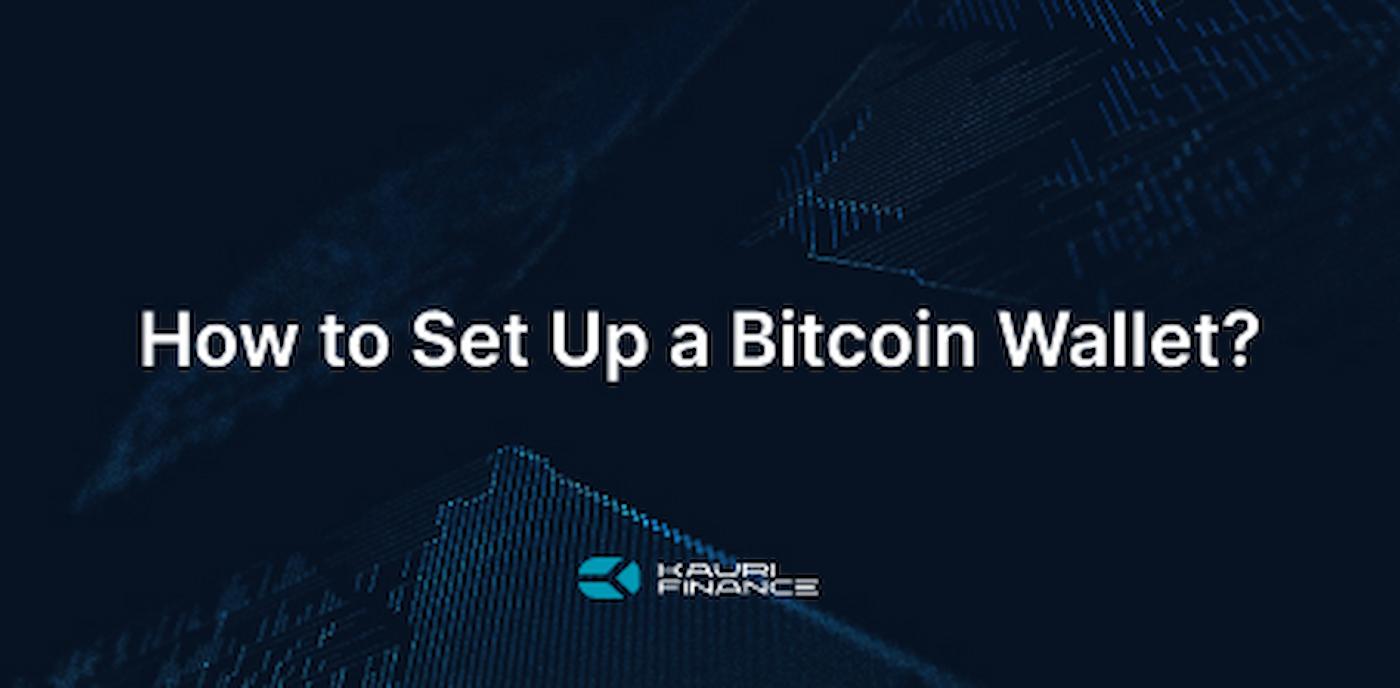
How to Set Up a Bitcoin Wallet?

Let's talk crypto, shall we? The crypto scene has been buzzing with excitement lately, and it looks like there's no slowing down. With people diving into the market, there's loads of potential for traders and investors to score big. But hey, before you can jump into the action and start buying and selling crypto, you gotta get yourself a crypto wallet. This guide is here to walk you through the whole shebang – why it's crucial, what cool features to keep an eye out for, and how to pick the perfect wallet that fits like a glove for your needs.
What is a Bitcoin wallet?
Similar to the traditional wallet you carry in your pocket, a bitcoin wallet serves as a digital storage solution for your cryptocurrency. However, instead of holding physical cash and cards, it safeguards a set of private keys linked to your bitcoin assets. Typically fortified with encryption, these wallets often require a password for access, enhancing security against unauthorized entry. Unlike the decentralized and shared nature of the Bitcoin network, a Bitcoin wallet operates solely under the control of its owner. It remains a private entity, unlike the distributed blockchain.
Ensuring the security of your bitcoin wallet is crucial, necessitating the implementation of a robust password or other protective measures to prevent it from falling into the wrong hands. A cryptocurrency wallet empowers users to perform various actions, including storing, sending, and receiving different coins and tokens. While some wallets focus on basic transactional functionalities, others offer additional features. For example, certain wallets integrate access to decentralized applications (dapps) built on blockchain technology. These dapps may extend capabilities such as allowing users to lend out their cryptocurrency, enabling them to earn interest on their holdings, among other opportunities.
Types of crypto bitcoin wallets
Hot and Cold Wallets
Wallets are defined as hot or cold based on internet connectivity. Hot wallets, connected to the internet, offer convenience but pose higher security risks. In contrast, cold wallets, stored offline, enhance security with reduced risk. Cold wallets, akin to safes or vaults, can storemoresignificant sums than carry-around wallets. Hot wallets are typically used for daily transactions, while cold wallets are preferred for long-term holdings. Hot wallets are easy to set up and provide quick accessibility, ideal for traders. Cold wallets, being hack-resistant, are suitable for holders. As a security measure, only a small percentage of funds are stored in hot wallets, with trading conducted directly from cold storage devices.
Hardware Wallets
These are hardware devices that manage public addresses and keys independently. Resembling USBs with OLED screens and side buttons, they are battery-less and connect to PCs, accessible via native desktop apps. Though priced between $70 and $150, they offer heightened security. While hardware wallets are more secure than hot wallets and more user-friendly than paper wallets, they fall short compared to web and desktop wallets. Available in various forms, they offer reasonable control levels but may pose challenges for beginners dealing with significant investments. Notable hardware wallets include Ledger Nano S and Trezor.
Paper wallets
Paper wallets originated when early cryptocurrency users would manually write or type their keys on paper, hence the name. These evolved to include keys and QR codes for compatibility with mobile device wallets. However, paper wallets are prone to damage or loss, leading many cryptocurrency owners to abandon their use. Nonetheless, utilizing a paper wallet is still feasible if proper storage measures are taken, such as placing it in a secure safe or deposit box. Periodically checking the paper wallet to ensure it remains intact and undamaged is advisable to prevent deterioration over time.
Desktop Wallets
These are software packages installable on operating systems, progressively gaining significance over time. Given the inherent security risks of systems connected to the internet, antivirus software is essential. Instead of leaving cryptocurrencies on exchanges, desktop wallets for bitcoins should be utilized. They rank as the third most secure method for storing cryptocurrencies and represent the optimal choice for cold storage on a completely clean system. Offering ease of use, privacy, and anonymity, desktop wallets eliminate the involvement of third parties. Regular computer backups are imperative. Popular desktop wallets include Exodus, Bitcoin Core, Electrum, KAURI, etc.
Mobile Wallets
Tailored for smartphones, mobile wallets resemble desktop wallets but are optimized for mobile use, employing QR codes for transactions. While convenient for daily operations, they are susceptible to malware. Encryption of mobile wallets is vital to enhance security. Despite their practicality and suitability for on-the-go use, mobile wallets are vulnerable to viruses. Examples of mobile wallets are Coinomi and Mycelium.
Web Wallets
Accessed via internet browsers, web wallets store private keys, making them susceptible to DDOS attacks. They can be categorized as hosted or non-hosted, with non-hosted wallets preferred for retaining control over funds. Although the least secure option, they are distinct from hot wallets and suitable for small investments, facilitating quick transactions. Examples of web wallets include MetaMask and Coinbase.
Custodial Wallets and Non-Custodial Wallets
Apart from hot and cold wallets, it's crucial to grasp the difference between custodial and non-custodial wallets.
Custodial Wallets:
- Third-Party Control: Custodial wallets are offered by third-party service providers like cryptocurrency exchanges or online wallet platforms. These providers handle your private keys and safeguard your cryptocurrencies on your behalf.
- User-Friendly: They're usually designed to be user-friendly, making them ideal for beginners or those who prefer a simpler approach to managing their digital assets. They're typically easier to set up and use.
- Recovery Options: Many custodial wallet providers offer options for account recovery if you forget your password or lose access to your account. While convenient, it also means the service provider has some control over your assets.
- Risk Factors: The main risk is that the service provider could be targeted by hackers. If their security is breached, your funds could be vulnerable. Additionally, the provider's terms and conditions might impact your access to your funds.
- Examples: Popular examples of custodial wallets include those provided by cryptocurrency exchanges like Coinbase, Binance, and Kraken.
Non-Custodial Wallets:
- Absolute Control: Non-custodial wallets grant you total command over your private keys and, thus, your cryptocurrencies. You retain the responsibility for safeguarding and managing your assets.
- Heightened Security: These wallets prioritize security and confidentiality. As you possess the private keys, the risk of your funds being compromised through a third-party breach diminishes significantly. This makes them an optimal choice for individuals who prioritize robust security measures.
- Privacy and Anonymity: They offer an elevated level of privacy and anonymity, given that your financial transactions and holdings remain unaffected by third-party data collection practices.
- Self-Reliance: While non-custodial wallets offer increased control, users must bear the responsibility of ensuring the security of their private keys. Losing access to these keys could result in the irreversible loss of funds, with no recourse for recovery.
- Examples: Hardware wallets such as Ledger Nano S and Trezor, and software wallets like Electrum, MyEtherWallet, and Trust Wallet exemplify non-custodial wallets.
The decision between custodial and non-custodial wallets hinges on your preferences and priorities. If convenience and trust in a third party managing your assets suit your needs, custodial wallets may suffice. However, if robust security, privacy, and complete autonomy over your cryptocurrencies are paramount, non-custodial wallets offer the ideal solution. It's imperative to select a wallet type that aligns precisely with your requirements and desired level of control over your digital assets.
How can I create a Bitcoin wallet?
4 essential steps on how to set up a bitcoin wallet
- Choose a software wallet app. Begin by selecting a reputable wallet provider from the available options in the market. Each wallet offers distinct features and security measures, so thorough research is crucial. We recommend creating a Bitcoin wallet at KAURI Crypto Wallet.
- Download the wallet app. Once you've chosen a suitable software crypto wallet, download the app onto your phone or computer. Installing the app ensures convenient access to your crypto assets. Be sure to download the app from the official app store or the provider's website to avoid potential security risks from malicious software.
- Create an account. Proceed to create an account by providing basic information such as your name, email address, and a robust password. Some wallet apps may require identity verification, which typically involves submitting a government-issued ID and a selfie.
- Transfer your assets. After setting up your software crypto wallet and account, transfer assets into your wallet. You can do this by depositing funds from a bank account, exchanging cryptocurrencies, or receiving them from another wallet. Mostsoftware wallets support multiple cryptocurrencies, enabling you to transfer various assets. To fund your wallet, obtain the wallet address and use it to send the assets. Some wallets also support QR codes for simplified transfers.
What is the safest Bitcoin wallet to use?
Our top recommendation for crypto enthusiasts seeking a hot wallet is the Kauri Crypto Wallet, renowned for its user-friendly interface and robust security measures, endorsed by a reputable exchange. The Kauri Crypto Wallet features an intuitive design, boasting a simple three-tab layout and easily identifiable functions. Compatible with major bank accounts, it supports a wide range of popular coins like Bitcoin, Litecoin, Dogecoin, and BNB, along with ERC-20 tokens and those on EVM-compatible blockchains.
It's crucial to differentiate between the Kauri exchange and the Kauri wallet. While the Kauri exchange is a well-established crypto trading platform, storing digital assets in its web wallet facilitates trading but exposes coins to heightened cybersecurity risks. In contrast, the Kauri wallet operates independently of the exchange and is non-custodial, ensuring that your private keys remain stored on your device rather than Kauri's servers. This setup offers peace of mind, as your currencies are safeguarded from potential account lockouts or website cyberattacks.
